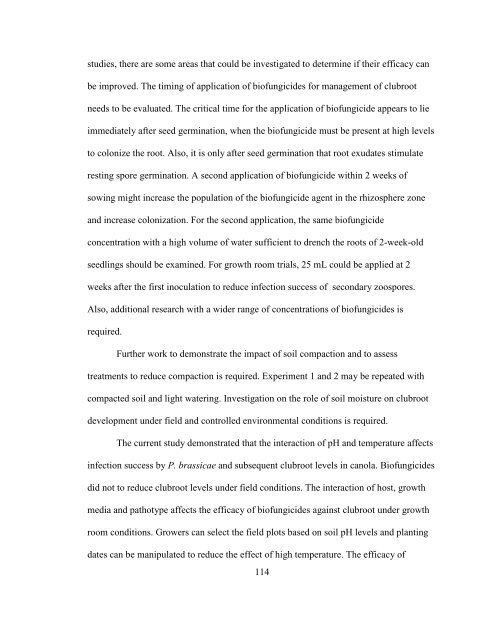Hema Kasinathan Thesis May 1 2012.pdf - Atrium - University of ...
Hema Kasinathan Thesis May 1 2012.pdf - Atrium - University of ...
Hema Kasinathan Thesis May 1 2012.pdf - Atrium - University of ...
Create successful ePaper yourself
Turn your PDF publications into a flip-book with our unique Google optimized e-Paper software.
studies, there are some areas that could be investigated to determine if their efficacy canbe improved. The timing <strong>of</strong> application <strong>of</strong> bi<strong>of</strong>ungicides for management <strong>of</strong> clubrootneeds to be evaluated. The critical time for the application <strong>of</strong> bi<strong>of</strong>ungicide appears to lieimmediately after seed germination, when the bi<strong>of</strong>ungicide must be present at high levelsto colonize the root. Also, it is only after seed germination that root exudates stimulateresting spore germination. A second application <strong>of</strong> bi<strong>of</strong>ungicide within 2 weeks <strong>of</strong>sowing might increase the population <strong>of</strong> the bi<strong>of</strong>ungicide agent in the rhizosphere zoneand increase colonization. For the second application, the same bi<strong>of</strong>ungicideconcentration with a high volume <strong>of</strong> water sufficient to drench the roots <strong>of</strong> 2-week-oldseedlings should be examined. For growth room trials, 25 mL could be applied at 2weeks after the first inoculation to reduce infection success <strong>of</strong> secondary zoospores.Also, additional research with a wider range <strong>of</strong> concentrations <strong>of</strong> bi<strong>of</strong>ungicides isrequired.Further work to demonstrate the impact <strong>of</strong> soil compaction and to assesstreatments to reduce compaction is required. Experiment 1 and 2 may be repeated withcompacted soil and light watering. Investigation on the role <strong>of</strong> soil moisture on clubrootdevelopment under field and controlled environmental conditions is required.The current study demonstrated that the interaction <strong>of</strong> pH and temperature affectsinfection success by P. brassicae and subsequent clubroot levels in canola. Bi<strong>of</strong>ungicidesdid not to reduce clubroot levels under field conditions. The interaction <strong>of</strong> host, growthmedia and pathotype affects the efficacy <strong>of</strong> bi<strong>of</strong>ungicides against clubroot under growthroom conditions. Growers can select the field plots based on soil pH levels and plantingdates can be manipulated to reduce the effect <strong>of</strong> high temperature. The efficacy <strong>of</strong>114
















